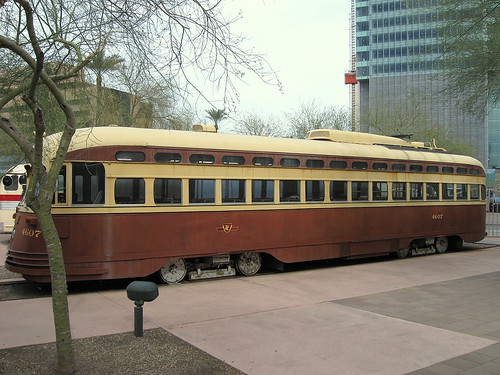
So far on this blog, I have discussed where some of Toronto’s PCC streetcars have gone after serving here. Five ex-TTC streetcars are in active service in Kenosha, Wisconsin, one being reused as a seating area for a rural burger joint, and one sits rusting in a field between Hamilton and Guelph.
I got to visit another member of the Toronto PCC dispora, in Phoenix, Arizona. PCC 4607, rebuilt in the 1980s and retired in 1995, was one of two streetcars shipped down to the Grand Canyon State. One is in active storage in Tucson as part of that city’s heritage streetcar route (more on that in a later post), and one sits along side two old Phoenix city buses in front of the downtown bus terminal, protected from vandals by a metal fence.
Metro Light Rail
Phoenix is also the latest US city to build a new light rail system. There is a single, 32-kilometre long route that connects most of the region’s main trip generators – Uptown Phoenix, a secondary office cluster and the cultural district; Downtown Phoenix, Sky Harbor Airport (via a shuttle bus), Downtown Tempe and Arizona State University. It also barely enters Mesa, North America’s second largest suburban municipality (after first-place Mississauga and just larger than third-place Brampton). Further extensions may take the LRT to the large Metrocenter Mall to the northwest and Downtown Mesa to the east.
 LRT on St. Clair/Transit City type ROW in Apache Boulevard, Tempe. Note new development on right.
LRT on St. Clair/Transit City type ROW in Apache Boulevard, Tempe. Note new development on right.
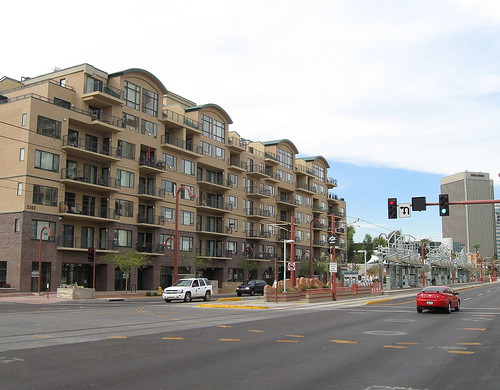 Avenues-style development on Central Avenue
Avenues-style development on Central Avenue
The Valley Metro LRT runs entirely on the surface, mostly in the centre of major streets in reserved median, much like Spadina, St. Clair and most of the proposed Transit City lines here in Toronto. However, a few portions run on former railway spurs, particuarly in Tempe. The Kinki Sharyo partial-low-floor cars are always coupled in two-car trains, and are surprisingly well patronized, even in the evening hours. In each car is a section where bicycles can be stowed, and many stations have bike locks (all buses have bike racks here). Tempe, the most progressive city in the “Valley of the Sun”, has built a new transportation center with secured indoor bike storage amongst other amenities serving transit commuters.
Stations are minimalist, but have some flair. Interestingly designed shades protect against the Sun, and each stop has a water fountain. Vending machines at stop entrances sell tickets and passes – a day pass can be purchased (with a smart card, cash, credit or debit) for only $2.50 good on all buses and the LRT. Mid-level platforms allow for pure level boarding with the low-floor train doors, which load quickly. Art and interpretive plaques add some local identity and interest. While there are electronic displays, a next train countdown is missing, needed as trains come as infrequently as every 20 minutes in the evenings.
In a smaller metro area where transit’s modal split is low, LRT is an ideal use of technology to attract ridership. Phoenix’s wide roads certainly help making the lines easier to build, and mid-rise development is underway along the LRT in low-rise and sprawling Phoenix.
The service, with all-door loading and signal priority that actually works, the service makes surface LRT look like a very good technology, particularly for Toronto’s wide suburban streets. In Phoenix, left turn cycles at intersections don’t hold up transit, trains move near the speed of car traffic with signal priority, station spacing appears to be ideal, but varies based on the local area (the relatively vibrant Uptown district has closer spaced stations than industrial Washington/Jefferson). The only downside is the service levels. I can only hope that the Transit City lines can offer the same amenities and speed I experienced in Phoenix, as I have unfortunately found myself skeptical of much of the plan.
 LRT interior, taken near northwest terminus of route in Phoenix.
LRT interior, taken near northwest terminus of route in Phoenix.


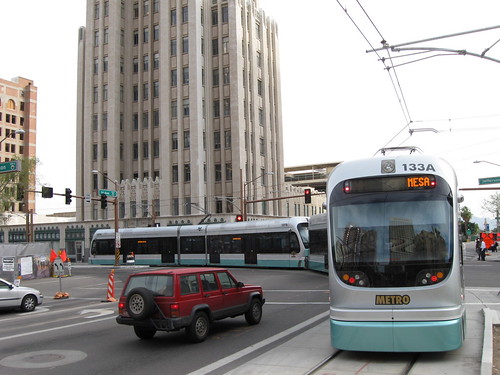
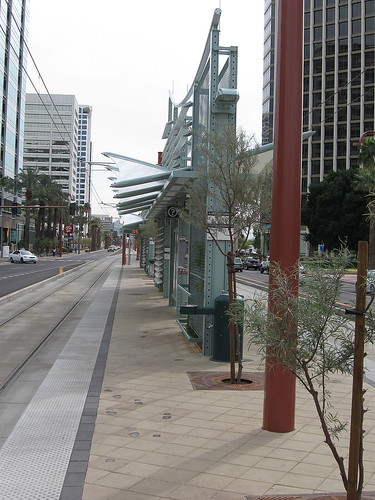
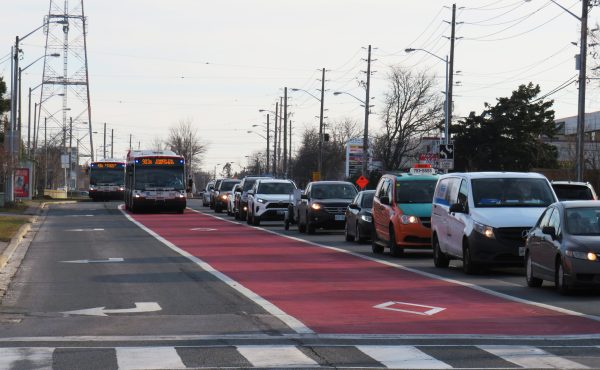


16 comments
Thanks Sean for this interesting post.
Though, I find it a little eerie to see Toronto’s transit past on display at other n. american cities and not here, don’t you?(*kinda like having a NYC subway car(*w/cool graffiti on it mind you)(That ones for you SHawn) on display here)
Why doesn’t Toronto have cars like these on display? Or are there?
Gotta say though, those LRT’s look pretty sweeeeeeeet. I really hope the ones that are coming here will work just as well. Considering our climate.
I’m also worried about the functionality of the LRT system in Toronto. We all know what happens to the SRT when it snows.
There is no problem with LRT and snow. Correct me if I’m wrong, but I think SRT’s issues have to do with signaling and its elevated trackway. 90 years of streetcars in Toronto show that good old surface transit does just fine in the snow.
Glad to see more photo evidence of yet another US city kicking our ass. Dallas, Denver, Minneapolis, Houston, Charlotte, and now freaking Phoenix, the antichrist of urbanity… who would have ever imagined? Oh, for the days when Torontonians could mock American cities and their decrepit transit — and they still do, which is why it these essays are helpful to get people’s heads out of the sand. Letting malcontents fight LRT on St. Clair due to their hyperlocal concerns misses the bigger picture — other cities are implementing these lines, so GET IT DONE.
Yes, put some old PCCs out on display (like Phoenix, a place with zero heritage), get them running tourist routes (like SF, which has less downtown trackage than Toronto but makes it work brilliantly) and put the damn streetcars on the map (like almost every other city in the world). Argh.
‘ ‘
Maria: the Scarborough RT is a victim of its exotic, gee-whiz technology. The Transit City LRT vehicles are going to operate on the same principles as the existing streetcars, so they shouldn’t be any more vulnerable to the weather.
Now that I think of it, though, I suppose that there could be vertical clearance problems with the low-floor design that would hang the cars up at the crests of snowy hills. It’d all depend on how tight that clearance is.
(Maybe they could put a plow on the front!)
In Minneapolis, a lot of their LRT system has a different surface than shown here in Phoenix or as we experience it with streetcars. It looks more like heavy rail tracks, which I can only assume is to help keep snow from building up at the front of the vehicle.
Toronto doesn’t have PCCs on display because they have them in operation. They have two of them available for charter and they usual have one or both out on the 509 Waterfront route on summer holidays, like Canada Day.
The TTC used to have a tourist route with historic streetcars called Belt Line but it was cut years ago.
There won’t be the problems with winter on the Transit City routes that the SRT has. I believe the problem with the SRT is related to the power pickup along the ground. Transit City will use overhead wires like other streetcars. It looks like they might come to the senses can convert the SRT to an LRT.
Streetcars downtown have problems with car parking too close to the track because of snowbanks, but with the wide streets Transit City will use that won’t be a problem.
Low-floor vehicles aren’t any closer to the tracks. They will be 13″ above, just as they are right now. The difference is the way the wheels and axles are constructed.No issue with snow today, no issue in the future.
uSky: We can still mock US cities for electing idiots like Maricopa County Sheriff Joe Arpaio (who almost makes Julian Fantino look like a card-carrying member of the ACLU in comparison). One of his recent ideas was to transport prisioners from Sky Harbor Airport to the downtown holding jail via the light rail, even though that requires a transfer to/from the airport shuttle. (He’s the guy who runs a tent city and operates chain gangs complete with black-and-white striped uniforms).
I’m still amazed by how efficient some cities can build and operate ‘quasi-LRT’ like the surface system used in Phoenix. As I recall, most US LRT systems are mostly in private rights-of-way. If Transit City was built and operated as well(with 2-3x the frequency and except Eglinton, of course) Toronto would be lucky. And with a DRL, more Rocket/express routes and real regional rail, would be just fine for transit.
Did you notice that “no left turn — streetcar” light in the fourth picture? I’ve seem something similar in Salt Lake City.
Dear Mr. Giambrone, when can we have an LRT system for grown-ups that takes precedence over cars and traffic signals, like they do in the United States?
We’ve been spineless in Toronto when it comes to streetcar priority signals. It ought to end with Transit City.
My sense is that the left turn operates the same as the Spadina or St. Clair left turns and the “streetcar” LED sign is to reinforce it. The left turn signal is protected only, like on St. Clair (i.e. you are not permitted to turn left if you don’t have a green arrow). It’s possible that there could be some minor variation in some of the parameters.
Most of the Minneapolis system appears to be more in the Calgary mould, where even street running is more akin to a light version of heavy rail, whereas the Phoenix pictures appear to be more of the Toronto model (a beefed-up version of a streetcar). Wikipedia suggests it has an average speed of 40 km/h, but I don’t know how much of this is the Toronto-style trackage and how much is closer to the Minneapolis model that permits higher speeds.
Edmonton is home to three of the TTC’s old PCC’s as well, including one that was part of the rebuild program for the Harbourfront LRT. That one runs regularly inside the Fort Edmonton historic park.
More info:
http://www.edmonton-radial-railway.ab.ca/ttc_4612.htm
Phoenix! I’m so embarrassed! I wonder where they got the funds. Probably the Feds. I can”t imagine Steven has ever taken a bus.
I’ve got a shovel to put in the ground. Three million for the same conclusion. Get it done already!
Phoenix had streetcars way back when decades ago, but they were replaced by buses in 1948. One of their original cars is preserved at the Phoenix Trolley Museum. See http://www.phoenixtrolley.com Apparently there was quite a lot of enthusiasm for the light rail line (of course there were detractors) and it’s doing business above expectations in its first few weeks. Here in Toronto we have people fighting light rail, and letters to the editor telling us to “get with the modern times and get rid of streetcars, like REAL cities”!!. We need to do LRT right and get people onside!
Rob, I would disagree with your assessment. US cities face far more opposition to light rail than Canadian cities yet somehow they are so awash with cash, taxes, bonds and other funding mechanisms that they are able to somehow still get them built.
For example, in the US you have:
– Vast swaths of suburbanites who assume public transit is used by inner-city criminals and won’t support it – http://www.jsonline.com/news/opinion/32538794.html
– Randal O’Toole – http://en.wikipedia.org/wiki/Randal_O%27Toole
– Libertarians – http://ti.org/antiplanner/
– Right wing activists who oppose any government program that reduces independence, especially light rail – http://speedy.wscpdx.org/publications/views/views19/light-rail.pdf
– These idiots – http://www.youtube.com/watch?v=pRD3o578lhQ
In Canada, you have much higher use and support for transit, but the country is so @##!%#^^!$#! poor that the shoddy leftovers of what does get built drives everyone batty, creating opposition from drivers who have never seen sleek train in their own ROW, or from local businesses who can outyell a weak, local-politician-controlled transit agency.
If you want to see a country that has enthusiasm for light rail, go to France. (Warning – viewing the images on this page will make Torontonians violently ill – http://www.lightrailnow.org/news/n_lrt_2008-01a.htm)
As much as I want the sleek European style transit to happen sooner, I think we need to put Transit City into perspective. The TTC’s current light rail proposal is 5 times greater (length and cost) than any similar project in North America. Thus, its going to take a bit more time. Phoenix has one line, built it over a pretty long period, and it carries fewer daily passengers than Queen Street. Rather than crapping all over TTC–which seems to be the only thing many spacing commenters are willing to do– let’s champion the fact that our streetcar/light rail when done will far surpass every city on the continent.